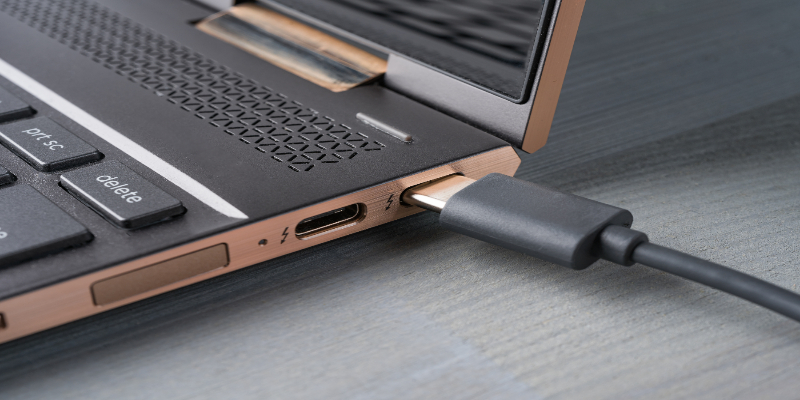Disclaimer: This post may contain affiliate links, meaning we get a small commission if you make a purchase through our links, at no cost to you. For more information, please visit our Disclaimer Page.
You’ve probably heard that it’s not a good idea to use a laptop while it’s plugged into power.
Using a laptop while charging it is okay. You don’t need to worry about overcharging or overheating because it is less likely to happen. A laptop with a lithium-ion battery doesn’t overcharge because of the battery’s mechanism.
Table of Contents
What happens when we use a laptop while charging?
Nothing wrong will happen when you use a laptop while charging. If you’re thinking about an explosion or catching fire, that won’t happen on your laptop as long as it’s at the right temperature. If you use your laptop while it’s charging, the lithium-ion battery charges as usual when it’s not fully charged. If you’re saving your time, using your laptop while charging is a good idea.
It’s safe for a lithium-ion battery to charge it when it’s not fully discharged. Yet, periodically, you need to discharge it for calibration although new batteries used in the newer model of laptops have self-calibration.
If you own an older version of a laptop, you must calibrate it. To calibrate a battery, you need to fully discharge it then charge it until it reaches its full capacity.
The advantage of battery calibration is that you’re helping your laptop to recognize the real capacity of the battery so it can project the right battery level. When a battery is not calibrated, what usually happens is that the laptop projects a wrong battery level.
If you don’t calibrate your battery, your laptop may show that the battery level is fully charged when the truth is it’s only 90%.
Is it OK to use a laptop while charging?
It’s okay to use a laptop while it’s charging. But it’s on the premise that your laptop uses a lithium-ion battery. Overcharging does not affect lithium-ion batteries, unlike nickel-based batteries.
Overcharging a battery
NiMH battery, a nickel-based battery, has a low tolerance to overcharging, which can lead to a loss in battery cycle and battery capacity. At higher pressure, NiMH battery temperature increases leading to the loss of electrolytes. Therefore, if your laptop has a NiMH battery, it’s advisable not to use it while charging.
On the other hand, the lithium-ion battery doesn’t overcharge at all. It’s designed with a control system that prevents overcharging. The system instructs the battery to stop charging when it reaches full charge capacity.
So, if someone tells you not to use your laptop while charging it because you may overcharge the battery, ditch the advice if you’re using a lithium-ion battery. You can charge the lithium-type battery almost 500 times.
However, to avoid compromising the safety of the lithium-ion battery, you need to keep it at the peak cut-off for a shorter period. Cutting it off minimizes the stress that may cause damage to the battery. When you stop charging the battery, the voltage, and the voltage drops. Then it will settle between 3.70 V/cell and 3.90 V/cell, which is safer for the battery.
The voltage elevation lasts for a long period when the battery receives a fully saturated charge. On the other hand, a less saturation charge has a shorter period of voltage elevation.
But what you need to remember when using your laptop is the duration of its usage. Are you going to use it for a short period or a long period? You must also consider the temperature of the environment. Is it cold or is it hot?
If you plan to use your laptop for a short period, let’s say an hour, even in a hot environment, it’s fine to use your laptop while charging. If you’ll it for a long period yet in a cold environment, it’s fine as well. However, if you’ll use it for eight hours in a hot environment, the problem may start to arise.
Overheating of battery
Overheating affects a lithium-ion battery’s performance. Based on a study, the performance of a lithium-ion battery decreases by almost more than doubled when it reaches 45C or 113F. The temperature is already too hot for the battery that affects the battery cycle, which is directly proportional to the battery’s lifespan.
The study showed that when a battery reaches 25C or 77F, the first 200 cycles of the battery decrease by 3.3%. But when the temperature rises to 45C or 113F, the degradation level increases more than doubled. According to the test result, the degradation level hits 6.7%.
The data means that the lifespan of the battery decreases faster when it’s exposed to a higher temperature. If the battery has repeated exposure to a higher temperature, the battery’s lifespan gets shorter.
If you’re planning to use your laptop for a long period, it’s better to remove the battery if your laptop has a removable battery. However, if it doesn’t have a removable battery, make sure that you’re working in a cold environment. You can also use a USB fan to ventilate the laptop to keep the right temperature.
Is it better to use a laptop plugged in or on battery?
If your laptop has a removable battery, it’s better to remove it and plug it into an electrical socket. It’s better to do this especially if you’ll use your laptop as a desktop or you’re working from home. Most of the time, if you keep your laptop on for a long period, the temperature rises that affects the performance of the battery. So, it’s advisable to remove it.
When you keep the battery in storage, make sure that its battery level is 50%. It’ll help in the preservation of the battery so it can last for years.
If you’re lucky to have a laptop with a removable battery, it’s much better if you remove it before it reaches 100%. It’s safer if you keep the charge 80% below. Based on the information released by Battery University, the last 3% of the battery level before it reaches 100% takes up a lot of energy. The energy needed to charge the battery fully decreases its lifespan.
However, if your laptop’s battery is not removable, avoid charging it to 100%. A battery with a low battery level won’t receive high voltage eliminating the chance of a saturation charge. The low saturation charge is good for the battery as it helps in prolonging the battery life.
Voltage and discharge cycle
A fully charged battery has a 4.2 V/cell. In most cases, laptop users prefer charging the battery in full especially when they need to bring a laptop when an electrical socket is not available. However, this voltage is not ideal as it lowers the discharge cycle, which decreases the lifespan of the battery.
On the other hand, a battery with a battery level between 85% to 95% has a 4.10 V/cell. It showed in the study that the discharge cycle improves. It showed that the battery with low voltage has a high discharge cycle. When a high discharge cycle happens, the battery lasts longer.
Based on a study that compared several battery levels, it showed a significant improvement when the voltage decreases. One battery level is between 85% to 90%.
It has a discharge cycle improvement of between 300 to 1000 extra charges. On the other hand, the other battery level is between 70% to 75% that quadrupled the discharge cycle of the battery.
Conclusion
When using a laptop with a lithium-ion battery, you need to remember three things. It includes temperature, voltage, and battery level. When it comes to temperature, you must always keep your laptop in a cool place or make sure that it’s well-ventilated.
For the voltage, you need to make sure that the battery maintains a low voltage by ensuring that it has a low battery level. If you keep these three things in mind, you won’t experience any problem using your laptop.


